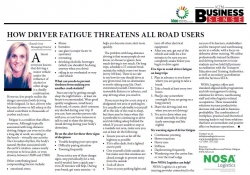Chantal Gray - Managing Director : How Driver Fatigue Threatens All Road Users2017-06-26 Almost everyone knows that driving a motor vehicle under the influence of alcohol or other drugs is a deadly
combination. However, few people realise the danger associated with driving while fatigued. In fact, drivers who become drowsy or fall asleep at the wheel contribute to thousands of crashes each year. Fatigue is a condition that affects everyone. Although typically associated with long-distance driving, fatigue can even set in after a long day at work, an outing at the beach - virtually any activity. The Circadian rhythm, the body's natural rhythm associated with the earth's rotation, causes nearly everyone to be less alert, or even drowsy, between 13h00 and 17h00. Other contributing (and compounding) factors include:
Start any trip by getting enough sleep the night before - at least six hours is recommended. Wear good quality sunglasses, avoid heavy foods and, of course, don't consume any alcohol during your trip. If you can, have another person ride with you, so you have someone to talk to and to share the driving. Avoid driving during your body's downtime. Be on the alert for these three signs of sleepiness
The problem with long-distance driving is that many people do not know, or choose to ignore, how much driving is too much. On long trips, schedule a 15-minute break outside the vehicle every two hours (every 160 km). There is no rule to say how far you should drive at any given time, but no destination is worth risking your life. Don't overextend yourself. Determine a reasonable distance in advance, and stop driving when you reach it. If you must stop for a rest, stop at a designated rest area or parking lot. It is usually not advisable to just pull off to the side of the road to sleep, but there may be times when this is preferable to continuing to drive and risk falling asleep behind the wheel. If you are unable to stop at a roadside rest area, make sure you can at least do the following:
NOSA Logistics is a private training provider committed to the success of its learners, stakeholders and the transport and warehousing sector as a whole, with a focus on defensive driver training. We utilise professionally-trained facilitators and driving instructors to train students and we hold full primary accreditation with the Transport Education and Training Authorities, as well as secondary accreditation with the Services SETA. NOSA Logistics offers unit standard aligned skills programmes and risk management training solutions for drivers, warehousing staff and other logistics-related occupations. These measurable solutions increase productivity, decrease risk and add to business profitability. The combination of workplace, practical and theoretical training leads to real-time solutions that have an immediate and positive effect on business operations. Contact us at: info@nosalogistics.co.za www.nosalogistics.co.za +27 (0)31 705 3225 Sources: https://arrivealive.co.za/Driver-Fatigue www.raf.co.za |
Chantal Gray - Managing Director : How Driver Fatigue Threatens All Road Users
Copyright © 2024 KwaZulu-Natal Top Business
